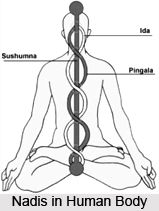 Any serious discussion about Pranayama is not complete without a reference of Nadi. The origin of the Nadi has a history behind it. It had occurred several times in all the Yogic literary works of the later period. Also, in the Yoga books of Pranayama, the writers like Bhagavan Patanjali and also Vysa mentioned about Nadi.
Any serious discussion about Pranayama is not complete without a reference of Nadi. The origin of the Nadi has a history behind it. It had occurred several times in all the Yogic literary works of the later period. Also, in the Yoga books of Pranayama, the writers like Bhagavan Patanjali and also Vysa mentioned about Nadi.
Meaning of Nadi
Nadi is special anatomical structures closely identified with the nerves of modern anatomy. It is the only standard one that has been derived over the year. However, though several interpretations have been derived by all the famous Yogic scholars of ancient India, these are not at all acceptable. According to traditional Indian medicine and spiritual science, Nadi can be defined as channels through which the energies of the subtle body are believed to flow. Then these channels connect at special points of intensity known as chakras. As per Kundalini yoga, there are three Nadis including ida, pingala, and sushumna.
The meaning of Ida in Sanskrit is `comfort`. Ida has a moon like nature and female energy with a cooling effect. Its responsibility is to control all the mental processes.
The term pingala is also a Sanskrit word which means `tawny`. Pingala has a sun like nature and male energy. Its duty is to control all the vital processes.
Sushumna is very important in Yoga and Tantra in general. It connects the base chakra to the crown chakra. Sometimes, alternative medicine also refers to Sushumna.
Position of the Three Nadis in Human Body
Ida is positioned to the left of the spine, whereas pingala is to the right side of the spine. On the other hand, Sushumna runs along the spinal cord in the centre, through the seven chakras: Mooladhaar at the base, and Sahasrar at the top of the head.
Activities of Nadi
It is believed that Nadis carry a life force energy known as prana. Prana is a Sanskrit word that refers to a life-sustaining force of living beings and vital energy in natural processes of the cosmic world.
The Ida and Pingala nadis are often considered as the two hemispheres of the brain. It is said that these nadis play an important part in empathic and instinctive responses. Many Yogis say that these two nadis can be stimulated through different Pranayama practices eventually which will stimulate the left and right sides of the brain.




















